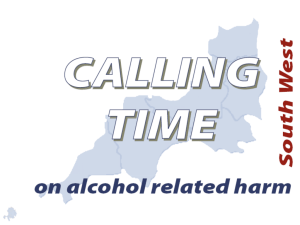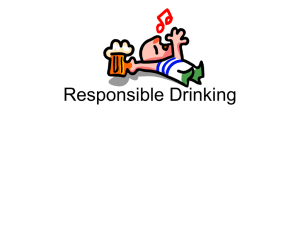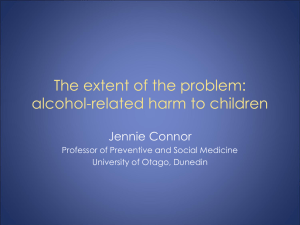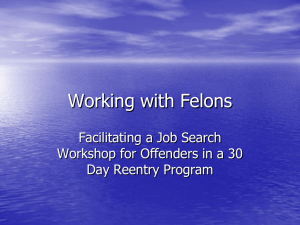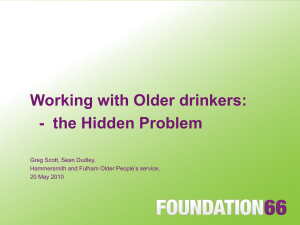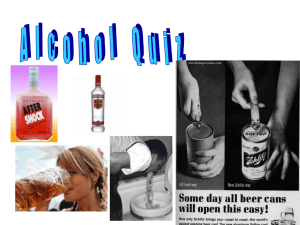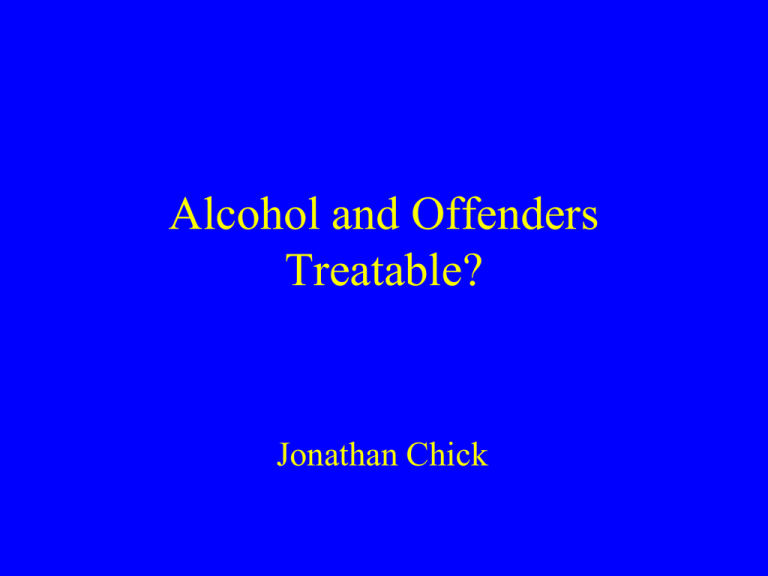
Alcohol and Offenders
Treatable?
Jonathan Chick
Is confrontation ethical.............
or effective?
• CONFRONTATION Miller WR, Benefield RG,
Tonigan JS. Enhancing motivation for change in
problem drinking: A controlled comparison of two
therapist styles. J Consult Clin Psychol 1993; 61:
455–61
• ‘DENIAL’ may be iatrogenic: Pomerleau O,
Pertschuk M, Stinnett J. A critical examination of some
current assumptions in the treatment of alcoholism. J Stud
Alcohol 1976; 37: 849–67
Communications with spouse/
employer/Court
Confidentiality and health workers:
If asked by a spouse or an employer to
comment on the patient’s condition, they
must have permission to do so.
Help the spouse, the employer, the Court to
clarify for themselves what they expect, and
give a clear, firm, but positive message.
Empathy in the ‘motivational
interviewing’ style
•
•
•
•
Respect for individual differences
Patience with gradual approximations
Express interest/concern
Patient senses you are trying to get on their
wavelength
• Acceptance that ambivalence is normal
The use of coercion in the out-patient treatment of
alcoholism
Rosenberg and Liftik (1976) J Stud Alc 37:58-65
Still in touch
at 5 months
Mandated
traffic
offenders
n=49
59% (2/3
‘doing well’)
Voluntary
patients
n=106 3%
Atlanta USA: repeat drunken offenders given
a suspended sentence (30-60 days in prison)
Bourne et al 1966 Q J Stud Alc,27:42-8
• Of 132, 78 chose to take disulfiram and
abstained for the duration of the suspended
sentence;
• 61 continued voluntarily for a further 6
months (or more)
Colorado Springs: repeat drunken offenders
were offered EITHER usual 90-day imprisonment
OR suspension of sentence contingent on completing
1 year of disulfiram-linked treatment (Haynes,1973, J Behav
Ther Exp Psy,4:31-2)
• Of 141, 138 chose attendance twice weekly to take
disulfiram
• At 1 year: 66 still taking disulf.
35 left town without permission
17 in jail
14 left town with permission
3 hospitalised
3 lost
• Mean arrest rate for whole group reduced from
3.8(preceding year) to 0.3 (year of study)
Outcome in 36 patients with drink-drive convictions
in past year, attending a Washington state clinic
Ward &Allwine,1979, Justice System Journal,5:107-11
Mean reconviction
rate next 12 months
Court
agreement:supervised
disulfiram n=22
0.23
Ordinary voluntary
treatment n=14
0.47 (p<0.05)
Patients’ choice
Many state they wish
‘to continue to drink but
without any problems’
Sources of evidence for
reduced drinking
• Outcome studies of abstinence goal
treatments
• Epidemiological longitudinal studies of
the natural history of alcohol use
disorders
• Studies of natural recoveries (selfchange)
• Experimental studies with an explicit
reduction goal
There are good outcomes with
low-risk drinking for some
patients
• Sobell MB, Sobell LC. Controlled drinking
after 25 years: How important was the great
debate? Addiction 1995; 90: 1149–53
South Dakota's 24/7 Sobriety Project
twice-a-day breathalyzer tests, or continuous alcohol
monitoring bracelets. Individuals who fail or skip
required tests are immediately subject to a short
jail term, typically a day or two.
reduced county-level repeat DUI arrests by 12% and
domestic violence arrests by 9%.
DUI rate fell from double national average to similar
Mixed evidence about whether the program reduced
traffic crashes.
(Kilmer et al (2013) Amer J Pub Hlth 103:37-43)
Cf ‘Contingency management’
Mutual Help Groups
• Proven effect of ‘12 step facilitation’
• Chits
• (even a patient on compulsion order –
escorted by staff, and two AA members)
• AA in prison
Past-year status by interval
since onset of dependence
100
90
Abstainer
% PPY population
80
70
Low-risk drinker
60
Asymptomatic risk drinker
(subclinical dependence)
50
40
30
Partial remission
20
Still dependent
10
0
<5
5 to 9
10 to 19
Interval (years)
20+
Slide courtesy of Dr. Ting-Kai Li (NESARC data)
Why offer reduced drinking
goals?
• In the UK, fewer than 10% of those with alcohol
problems ever enter treatment –why?
– Stigma
– Abstinence requirement
– Overly intensive demands of treatment
Collaborative exploration
• ‘Run the experiment’
You can’t learn to navigate in a ship that’s sinking:
antabuse, acamprosate, naltrexone, future medications, help in
early recovery
Antabuse : The Partnership Approach
• A partner is a person whom the patient asks to
observe him/her taking the Antabuse
• So that the tablets cannot be substituted, genuine
Antabuse is marked ‘C J O’
• To ensure the tablets are not put under the tongue
and removed later, they are dispersed in water
• Either daily, or 3 times/week e,g 2 on Monday, 2
on Wednesday, 3 on Friday
• If vomiting the tablet is suspected, partner stays
with patient for 30 minutes
• If patient decides to stop Antabuse, patient or
partner phones clinic to discuss the reason
The assessment:
non-judgemental, empathic,
collaborative
Start with the offender’s own concerns
• ‘What is your current main concern?’
• ‘Help me understand how this came about’
• What are the various factors in your view?
• Your offending- Where does your use of alcohol
fit in?
• Your health Have you used alcohol to help with
stress/insomnia
• What would your partner say if he/she were here?
COURT REPORTS
Deferred sentence
‘…If the Court deferred sentence, then I
would report in 3-6 months on whether the
offender has complied with the treatment
undertakings he has agreed to.’
Structured Deferred Sentence
• Scottish Government, 2008: this approach is to be
extended to cover courts across two Community Justice
Authorities areas - Glasgow and Tayside. The total funding
amounts to £667,000 per year.
• a low-tariff intervention providing structured social work
intervention for offenders post-conviction, but prior to
final sentencing. It is primarily aimed at offenders with
underlying problems such as drug or alcohol dependency,
mental health or learning difficulties or unemployment. It
is not used for violent, serious or sex offenders.
• When there’s no wish to change.
• Keep the dialogue open...
Prison and Retoxification
• AA in prisons
• Start Antabuse during custody or by the last
week
CHILD PROTECTION
CHILD PROTECTION
O’Brien report Oct 2003
35 recommendations
Number 20
•“That steps are taken to clarify when medical
duties of confidentiality towards a patient who
is caring for a child can be waived”
“At Risk” as defined in the Children
(Scotland) Act 1995
………….suffering, or likely to suffer significant
harm because of abuse or neglect. Abuse is
defined as ‘a deliberate act of ill treatment that can
harm or is likely to cause harm to a child’s safety,
well-being and development’. Neglect is the
‘failure to provide for, or to secure for a child the
basic needs of food, warmth, clothing, emotional
security, physical safety and well-being’.
‘At risk’
• A child living in a household where adults
misuse substances will be seen as potentially
‘in need’ and possibly ‘at risk’
• Practitioners should ensure that their
approach to care is non-judgmental so that it
does not deter parents and pregnant women
with alcohol/drug related problems from
engaging with services
• “If a child may be at risk of harm this will
always override….”
Confidentiality is conditional and not absolute
• Assessment for children “at risk”
– Generic
– Substance use related
• Consent to share information
Adults with Incapacity (Scotland) Act
2000 and ARBD
(alcohol-related brain damage)
‘Incapable’ means incapable of
• acting; or
• making decisions; or
• communicating decisions; or
• understanding decisions; or
• retaining the memory of decisions,
in relation to any particular matter, by reason of mental
disorder …
An adult shall not be treated as suffering from mental
disorder by reason only of ……dependence on alcohol or
drugs…or acting as no prudent person would act
In practice: use objective
measures
• Even when no sanctions apply, client does
not want to disappoint the therapist
• The client wants to try his experiment in
‘controlled drinking’
Make the breath alcohol test routine
Test at the beginning of the interview, before
the patient gives self-report
Use blood test markers
Assessment when patient claims he
takes Disulfiram (Antabuse)
Biological markers less essential if the
disulfiram is supervised by an objective 3rd
party e.g. at work, for the Court, at a
Clinic,
Supervised disulfiram
•
•
•
•
200mg daily
or 400mg Mon and Wed, 600 mg Friday
‘Dispersed in 50 ml water’
Check with the supervisor regularly that the drug
is still being taken
• Encourage supervisor
• Motivate the patient – review his/her rationale for
choosing this method; check on side effects, be
prepared to adjust slightly the dose
• Watch for neuropathy
FAST: stage 2
How often during the last year…………
……have you been unable to remember what
happened the night before because you had been
drinking?
……failed to do what was normally expected of you
because of drink?
….has a relative or friend, or a doctor or other health
worker been concerned about your drinking or
suggested you cut down?
fini


